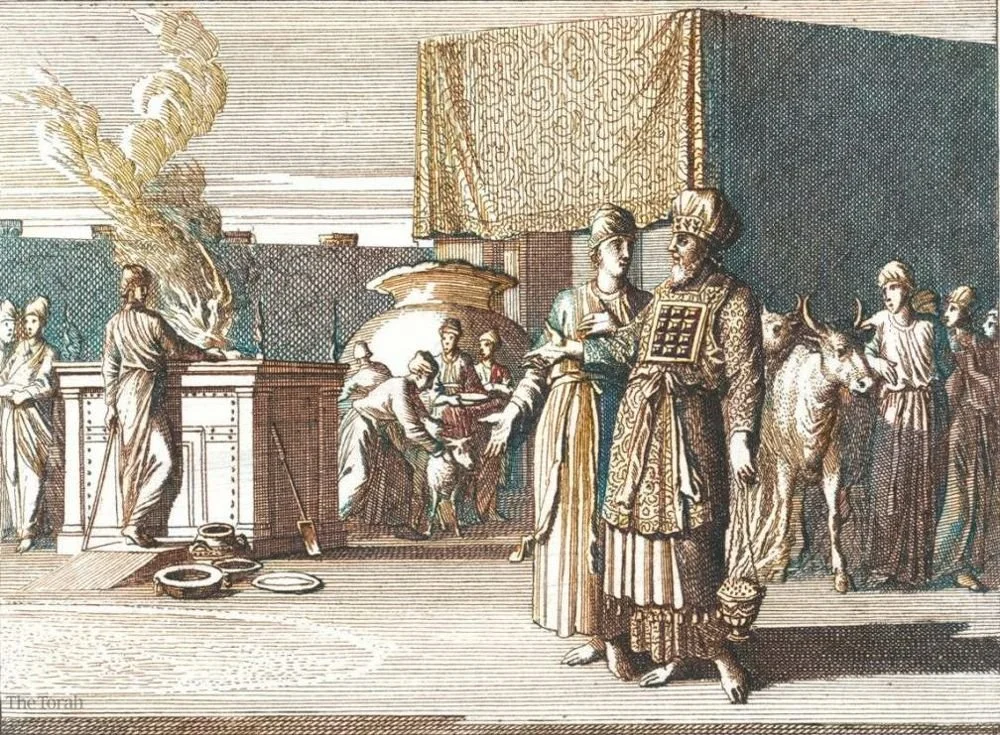
Triennial Reading Cycle 2
For Year 5784
Parshat Tetzaveh
Exodus 28:31-29:18
February 23-24, 2024
Since this portion is difficult to convey triennially, what follows is a general summary of the entire portion.
The Torah describes the following vestments the Kohaneem would wear. The clothes were not intended to be elegant, but to be distinctive and identifiable, analogous to the uniforms worn by police or firefighters. Although being able to identify the Kohayn was generally not a matter of life and death; it was important for the nation to easily recognize the people who fulfilled the spiritual needs of b’nai yisrael.
One of my favorite Jewish stories is about a shoemaker, who was renowned not only for his craft but for his wisdom. En route to a wedding hosted by his wealthy client, the shoemaker falls into a puddle of mud. Upon his arrival, the shoemaker is mistaken for a poor beggar and is immediately banished. With the assistance of another affluent nobleman/customer, the shoemaker returns to the wedding dressed regally. He is immediately embraced and offered a seat at the head table. During the meal, the shoemaker feeds his clothes; to indicate that the clothes seem to be more welcomed than the shoemaker himself. The lesson he imparts is that fools regard external clothing but disregard the soul behind the clothes. Such is the perspective we need to appreciate TETZAVEH.
Priestly clothing includes:
Ephod: An apron-like garment adorned with gold, blue, purple and scarlet
Breastplate: Worn over the ephod. The breastplate included twelve stones with the names of the tribes
Robe: Blue in color and adorned with pomegranates and bells
Gold Plate: Worn across the forehead and engraved with the words: HOLY TO ADONAY
Tunic: ankle length garment, standard fashion in the ancient Near East.
Turban: symbol of royalty.
Sash: A fine, embroidered wool, which was tied over the tunic
The garments were relatively modest, characteristic of the Priest’s inner self.
Other Highlights:
* The Torah describes the Installation Ceremony for the Priests and summarizes the daily sacrifices offered on behalf of the entire community. When Aaron and his sons offered their sacrifice, they put some of its blood on their ears, thumbs and toes. The Etz Hayyim Torah commentary explains that each of those body parts exacts a commitment from the Priests. As they place blood on their ears, the Priests vowed to listen carefully to the concerns of b’nai yisrael. The blood on their thumbs suggested that with their hands, they will act on behalf of the people and not merely listen. The blood on their toes suggested that the Priests would move quickly and resolutely to carry out their actions as honestly and as effectively as possible.
* The installation ceremony for the Priests would last seven days, calling attention to the gravity of their responsibilities. As I have explained many times over the years, our Torah details several public installation ceremonies, to highlight both the honorees as well as the entire nation. The seven-day ceremony enabled the Priests to gradually ease into their service. The ceremony also made an important statement to the general population: Take your Priests and their work seriously! When organizations plan installation ceremonies for incoming officers, the intent is to highlight the organization and not merely its leaders. Newly elected leaders may “poopoo” a formal ceremony but the pomp and circumstance is not just for them. We need to remind ourselves that the ceremony highlights the work done by a particular organization and supported by a loyal constituency.
* The Priests constructed an altar for burning incense. Incense was a common feature in such rituals, because it brought a much needed, pleasant fragrance to the procedure. Symbolically, the incense might remind Israel that the “ultimate fragrance” in the sacrificial procedure was the people’s loyalty to God and to their new Torah. As a fragrant smell brings us enjoyment, the “fragrance” of the Torah should bring joy and satisfaction to generations of Jews.
Haftarah Reading: Ezekiel 43:10-27
Ezekiel was a prophet, exiled to Babylonia when the Temple was seized and destroyed. In the latter chapters of his book, Ezekiel envisions a future return to Israel: The nation will renew its spiritual and ritual connection to Eretz Yisrael. In our Haftarah, Ezekiel describes the altar in a restored, future Temple. The altar provides the connection between the Torah reading and the Haftarah. In the future Temple, sacrifices will once again be offered; and a seven-day ceremony will mark the Priest’s return to active, spiritual duty.
In the newly restored Jerusalem, the people will re-establish the rituals described in the Torah. Those rituals are to be expressed from the heart, rather than observed as mechanical acts without devotion. The future Israel will be obedient to God and spiritually in sync for a new era.
Ezekiel’s details may not accurately reflect practice in the Second Temple period, but his general vision calls attention to how Jews longed for their Holy City - both in antiquity and during the two thousand years of exile until 1948.

